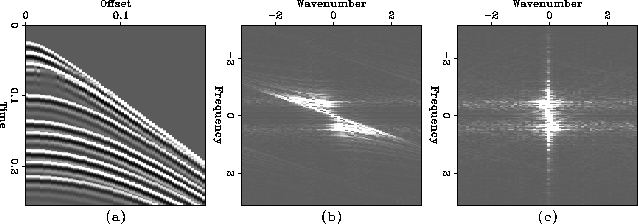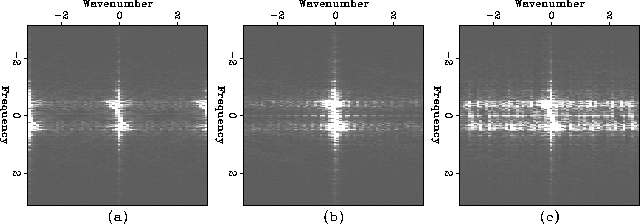




Next: RESULTS
Up: Ji and Claerbout: Trace
Previous: CONJUGATE OPERATOR
One of the most important considerations in interpolation is
to avoid interpolating aliased events.
It is very difficult to distinguish steeply dipping events
from aliased data.
NMO processing provides a good means of moving the steeply dipping
events to the nonaliased dip range of the frequency-wavenumber domain.
Figure 2 shows the spectrum of a CMP gather before and after NMO correction.
Notice that the NMO correction has significantly reduced the steep dips.
fig2
Figure 2 (a) Synthetic CMP gather,
(b) amplitude spectrum of the CMP gather, and (c) amplitude spectrum of
the NMO-corrected CMP gather.





If there existed any missing trace, its spectrum would spread over a wide
wavenumber range.
Figure 3 shows three amplitude spectra, which correspond to the
interlaced missing, truncated, and randomly missing CMP gathers, respectively.
Among the three spectra, only the amplitude spectrum of the interlaced missing
CMP gather clearly indicates that a conventional frequency-wavenumber domain
interpolation method can be applied ( i.e., Fourier transforming the data,
applying a high-cut filter, and inverse Fourier transforming).
The others, the amplitude spectra of truncated and randomly missing CMP
gathers, are blurred by the missing traces, and it is difficult to find
a clear-cut passband.
fig3
Figure 3 The amplitude spectrums of
NMO corrected CMP gathers of (a) the interlaced missing, (b) the truncated
missing and (c) the randomly missing traces.










Next: RESULTS
Up: Ji and Claerbout: Trace
Previous: CONJUGATE OPERATOR
Stanford Exploration Project
12/18/1997


